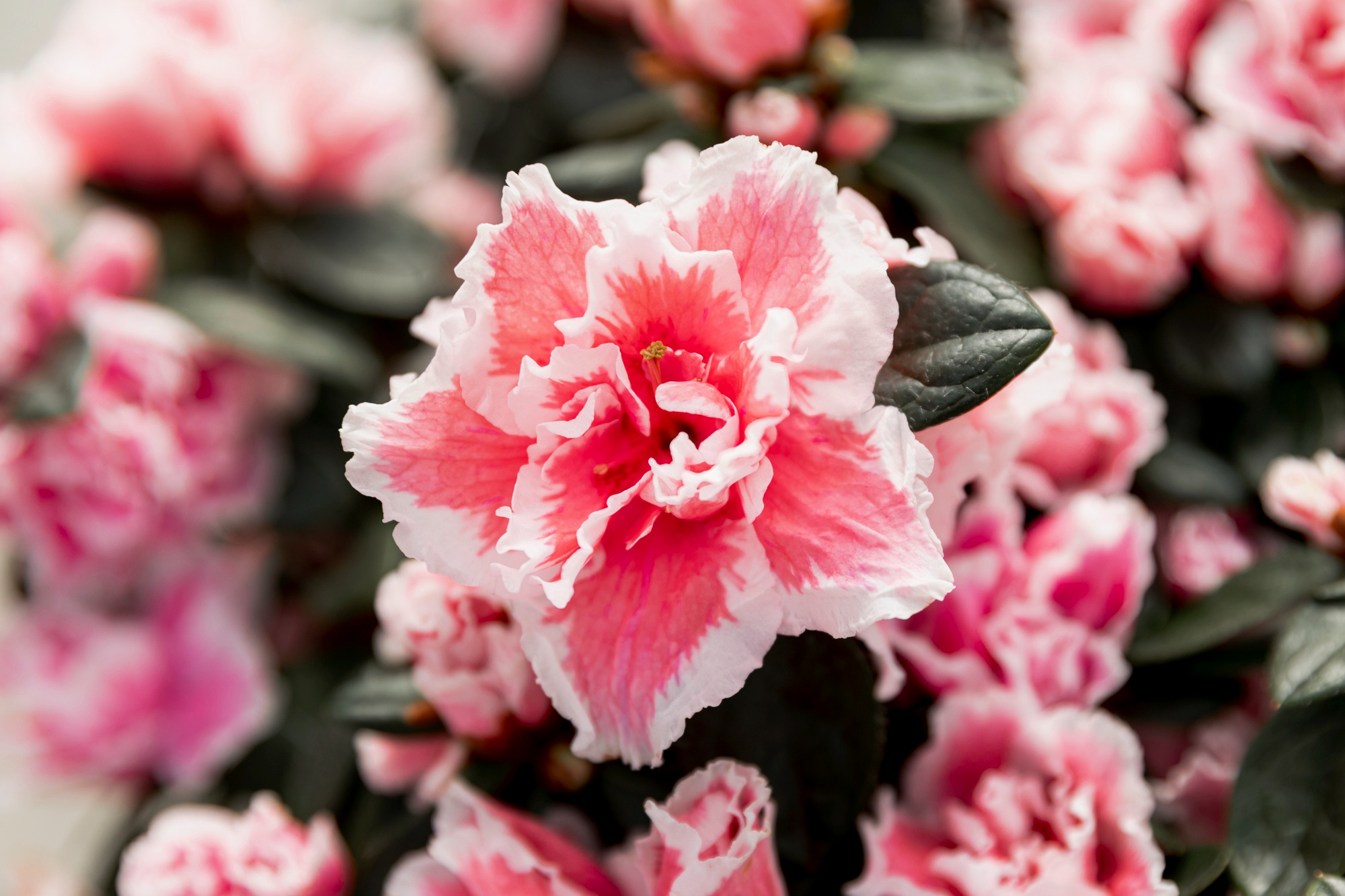Grow Azalea & Rhododendron: Expert Tips for Garden Soil & Care
Azaleas and rhododendrons are beloved for their stunning blooms and lush foliage, making them a staple in many gardens. However, to successfully grow azaleas, understanding their specific soil and care requirements is crucial. This article will delve into expert tips on the best soil conditions, care techniques, and maintenance for azaleas and rhododendrons, ensuring your garden flourishes with these magnificent shrubs.
What is the Best Soil for Azaleas and Rhododendrons?
One of the most critical aspects of growing azaleas is ensuring that the soil pH is within the optimal range. Azaleas prefer acidic soil, ideally with a pH of around 6.0. This level of acidity is essential because it allows the plants to absorb the nutrients they need for healthy growth and vibrant blooms. If your soil is alkaline, it can hinder the azaleas’ ability to thrive. Conducting a soil test can help determine the pH of your soil, guiding you to make necessary amendments. If you find that your soil pH is too high, you can lower it by adding soil amendments like sulfur or using ericaceous compost, which is specifically formulated for acid-loving plants like azaleas and rhododendrons.
What is Ericaceous Compost?
Ericaceous compost is a specialized growing medium that contains organic matter, peat, and other materials that promote acidic conditions. This type of compost is particularly beneficial for azaleas and rhododendrons, as it provides the right balance of nutrients while maintaining the desired soil acidity. When planting azaleas, incorporating peat-free ericaceous compost into the soil will enhance drainage and improve overall soil quality. This compost not only supports healthy root development but also encourages the plants to flourish with vibrant flowers. Always ensure that the compost you choose is free from any additives that could alter the soil’s pH.
How to Improve Soil Drainage for Azaleas
Proper drainage is vital for azaleas, as they are susceptible to root rot if the soil becomes waterlogged. To improve drainage, consider planting azaleas in a location with well-drained soil, avoiding clay soil that retains too much moisture. If your garden has heavy soil, you can amend it with organic matter such as compost or well-rotted bark to enhance drainage. Additionally, raised beds can be beneficial for azaleas, allowing excess water to drain away from the roots. Regularly monitoring the moisture levels in the soil and ensuring that it remains moist but not soggy will create an ideal environment for your azaleas.
How to Care for Azaleas in Your Garden?
Watering azaleas effectively is essential for their health and growth. These plants thrive best with consistent moisture, ideally from rainwater rather than tap water, which may have higher alkalinity. When watering, it is important to provide deep, thorough soakings, allowing the water to reach the root system. During dry spells, azaleas may require additional watering, especially in the early spring and late summer when blooming occurs. Aim to keep the soil slightly moist but avoid overwatering, which can lead to waterlogged conditions detrimental to the plants.
Best Fertiliser for Azaleas and Rhododendrons
Choosing the right fertiliser is another key aspect of how to care for azaleas. An ericaceous fertiliser, specifically designed for acid-loving plants, provides the necessary nutrients to support healthy growth and vibrant blooms. Fertilizing azaleas annually in early spring, just as new growth begins, will ensure that they receive the nutrients needed for robust flowering. Avoid fertilisers with high phosphorus levels, as these can be harmful to azaleas. Instead, look for a balanced fertiliser with a lower N-P-K ratio, tailored for azaleas and rhododendrons.
Pruning Tips for Azalea Shrubs
Pruning azaleas is an essential maintenance task that helps promote healthy growth and flowering. The best times to prune azaleas are right after they bloom, typically in mid to late summer, allowing the plants to set buds for the next season. When pruning, remove any dead or diseased wood and shape the plant to encourage an open structure that allows light and air circulation. Avoid heavy pruning, as azaleas bloom on old wood; instead, focus on light trimming to maintain their shape and remove any unwanted growth. Regularly checking your azaleas for signs of disease and pest infestations is also vital for their long-term health.
Can You Grow Azaleas in Pots?
Growing azaleas in pots is a viable option, especially if garden space is limited or if you wish to create a stunning display on patios or balconies. It’s important to choose a pot that is large enough to accommodate the root system and has adequate drainage holes to prevent waterlogging. Terracotta pots are excellent choices due to their breathability, but ensure that they are not too heavy for easy mobility. When planting your azalea in a pot, aim for a container that is at least 12 inches deep to allow enough space for root growth.
Potting Mix for Container Grown Azaleas
For potted azaleas, a high-quality potting mix is crucial. Opt for a peat-free ericaceous compost that provides the right acidity level and drainage for container-grown azaleas. The mix should contain organic matter to retain moisture while allowing excess water to escape. Regularly check the moisture level of the potting mix, as potted plants can dry out more quickly than those in the ground. Watering deeply but infrequently will help establish strong root systems while promoting healthy growth.
Care Tips for Potted Azaleas
Potted azaleas require specific care to thrive. Ensure that the pots are placed in a location that receives filtered sunlight, as direct sun can scorch the leaves. Monitor the moisture levels closely, as potted azaleas may need more frequent watering during hot weather. Fertilizing with an ericaceous fertiliser every 4-6 weeks during the growing season will support the plants’ nutritional needs. Additionally, consider repotting every couple of years to refresh the soil and provide more space for the roots to expand.
What are the Different Varieties of Azaleas?
When considering the types of azaleas to grow, it’s essential to distinguish between evergreen and deciduous varieties. Evergreen azaleas retain their foliage throughout the year, providing year-round interest in the garden. They often bloom in early spring and can maintain their leaves during the winter months. In contrast, deciduous azaleas lose their leaves in the fall, but they typically produce larger and more vibrant flowers in the spring. Understanding these differences will help you choose the best azalea varieties to suit your garden’s aesthetic and seasonal appeal.
Popular Azalea Varieties for Gardens
There are numerous varieties of azaleas that are popular among gardeners, each offering unique colors, sizes, and bloom characteristics. The Japanese azaleas are particularly renowned for their showy flowers and compact growth, making them ideal for smaller gardens. Additionally, varieties like ‘Gumpo’ and ‘Hino Crimson’ are favored for their stunning blooms and adaptability. For those looking for larger shrubs, the ‘Southern Indian’ azaleas are an excellent choice, boasting vibrant colors and a robust growth habit. Selecting the right variety can greatly enhance the visual appeal of your garden.
Bloom Times for Different Azalea Varieties
Understanding the bloom times for different azalea varieties can help you plan a garden that features continuous color throughout the spring. Early blooming varieties, such as ‘Pink Ruffle’ and ‘Rosy Lights’, often flower in late March to early April, while mid-season varieties like ‘George L. Taber’ and ‘Delaware Valley White’ typically bloom from April to May. Late-blooming azaleas, such as ‘Karen’ and ‘Satsuki’, can extend the flowering season into June. By selecting a mix of early, mid, and late bloomers, you can enjoy a colorful display of azaleas in your garden for an extended period.
How to Mulch and Maintain Azalea Plants?
Mulching azaleas is an essential practice that provides numerous benefits. A layer of mulch helps retain soil moisture, suppresses weeds, and regulates soil temperature. Additionally, organic mulch, such as shredded bark or pine needles, gradually breaks down and adds nutrients to the soil, enhancing its overall quality. Mulching also protects the shallow roots of azaleas from temperature extremes, particularly during the winter months. Aim to mulch azaleas annually to ensure they receive the full benefits throughout the growing season.
What Materials Can Be Used for Mulch?
When selecting materials for mulching azaleas, organic options are preferred. Shredded bark, pine needles, and wood chips are excellent choices, as they contribute to soil health while maintaining the necessary acidity levels. Avoid using materials that may alter the pH, such as limestone or alkaline-based mulches. Applying a 2-3 inch layer of mulch around the base of the plants will provide adequate coverage without smothering the roots. As the mulch decomposes, it will need to be replenished annually to maintain its effectiveness.
When to Apply Mulch to Azaleas
The best time to apply mulch to azaleas is in early spring, just before new growth begins. This timing ensures that the mulch will effectively suppress weeds and retain moisture during the growing season. Alternatively, you can also mulch in late fall after the plants have finished blooming. Applying mulch at this time will help insulate the roots against cold temperatures and provide nutrients as the organic matter breaks down. Regularly replacing the top layer of mulch will maintain its benefits and contribute to a healthier garden environment for your azaleas.

